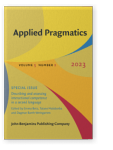Discussion
Testing and CA
The test makers’ perspective – a discussion paper
Article outline
- 1.Introduction
- 2.The test makers’ perspective on testing IC
- 2.1The practicality challenge
- 2.2The value-add of IC
- 3.The way forward
-
References
References (24)
References
Almeida, S., & Fernando, M. (2017). Making the cut: Occupation-specific factors influencing employers in their recruitment and selection of immigrant professionals in the information technology and accounting occupations in regional Australia. The International Journal of Human Resource Management,
28
(6), 880–912. 

Bachman, L. F., & Palmer, A. S. (2010). Language assessment in practice. Oxford University Press.
Canale, M., & Swain, M. (1980). Theoretical bases of communicative approaches to second language teaching and testing. Applied Linguistics,
1
1, 1–47. 

Dai, D. W. (2022). Design and validation of an L2-Chinese interactional competence test [Unpublished doctoral thesis]. The University of Melbourne.
Ebel, R. L. (1964). The social consequences of educational testing. Proceedings of the 1963 invitational conference on testing problems (pp. 130–143). Educational Testing Service.
ETS (2010). Linking TOEFL iBT scores to IELTS scores. Educational Testing Service.
Huth, T. (2021). Conceptualizing interactional learning targets for the second language curriculum. In S. Kunitz, O. Sert, & N. Markee (Eds.), Emerging issues in classroom discourse and interaction: Theoretical and applied CA perspectives on pedagogy (pp. 359–382). Springer. 

Malone, M. E., & Montee, M. (2014). Stakeholders’ beliefs about the TOEFL iBT test as a measure of academic language ability. ETS research report No. RR-4-42. Educational Testing Service. 

May, L., Nakatsuhara, F., Lam, D., & Galaczi, E. (2020). Developing tools for learning oriented assessment of interactional competence: Bridging theory and practice. Language Testing,
37
(2), 165–188. 

Ockey, G. J., & Chukharev-Hudilainen, E. (2021). Human versus computer partner in the paired oral discussion test. Applied Linguistics, 1–21. 

OET (2022). Taking the speaking sub-test. [URL]
O’Hagan, S., Pill, J., & Zhang, Y. (2016). Extending the scope of speaking assessment criteria in a specific-purpose language test: Operationalizing a health professional perspective. Language Testing,
33
(2), 195–216. 

Oxford University Press (2018). Wide Angle. Oxford
Pekarek Doehler, S. (2019). On the nature and the development of L2 interactional competence: State of the art and implications for praxis. In M. R. Salaberry & S. Kunitz (Eds.), Teaching and testing L2 interactional competence: Bridging theory and practice (pp. 25–59). Routledge. 

Pill, J. (2016). Drawing on indigenous criteria for more authentic assessment in a specific-purpose language test: Health professionals interacting with patients. Language Testing,
33
(2), 175–193. 

Roever, C. (2022). Teaching and testing second language pragmatics and interaction: A practical guide. Routledge.
Roever, C., & Dai, W. (2021). Interactional competence and language testing. In M. R. Salaberry & R. Burch (Eds.), Assessing speaking (pp. 23–49). Palgrave Macmillan. 

Roever, C. & Ikeda, N. (2022). What scores from monologic speaking tests can(not) tell us about interactional competence. Language Testing,
39
(1), 7–29. 

Roever, C., & Kasper, G. (2018). Speaking in turns and sequences: Interactional competence as a target construct in testing speaking. Language Testing,
35
(3), 331–355. 

Salaberry, R., & Burch, R. (Eds.) (2021). Assessing speaking in context: Expanding the construct and its applications. Multilingual Matters.
Sato, T., & McNamara, T. (2019). What counts in second language oral communication ability? The perspective of linguistic laypersons. Applied Linguistics,
40
(6), 894–916. 

Stivers, T. (2015). Coding social interaction: A heretical approach in conversation analysis? Research on Language and Social Interaction,
48
(1), 1–19. 

Youn, S., & Burch, R. (Eds). (2020). Where conversation analysis meets language assessment [Special issue], Papers in Language Testing and Assessment,
9
(1).
Zechner, K., & Evanini, K. (Eds.). (2020). Automated speaking assessment: Using language technologies to score spontaneous speech. Routledge.
Cited by (1)
Cited by one other publication
Lam, Daniel M K
2024.
Worked examples for peer interaction: a feedback and learning resource.
ELT Journal 
This list is based on CrossRef data as of 4 august 2024. Please note that it may not be complete. Sources presented here have been supplied by the respective publishers.
Any errors therein should be reported to them.
